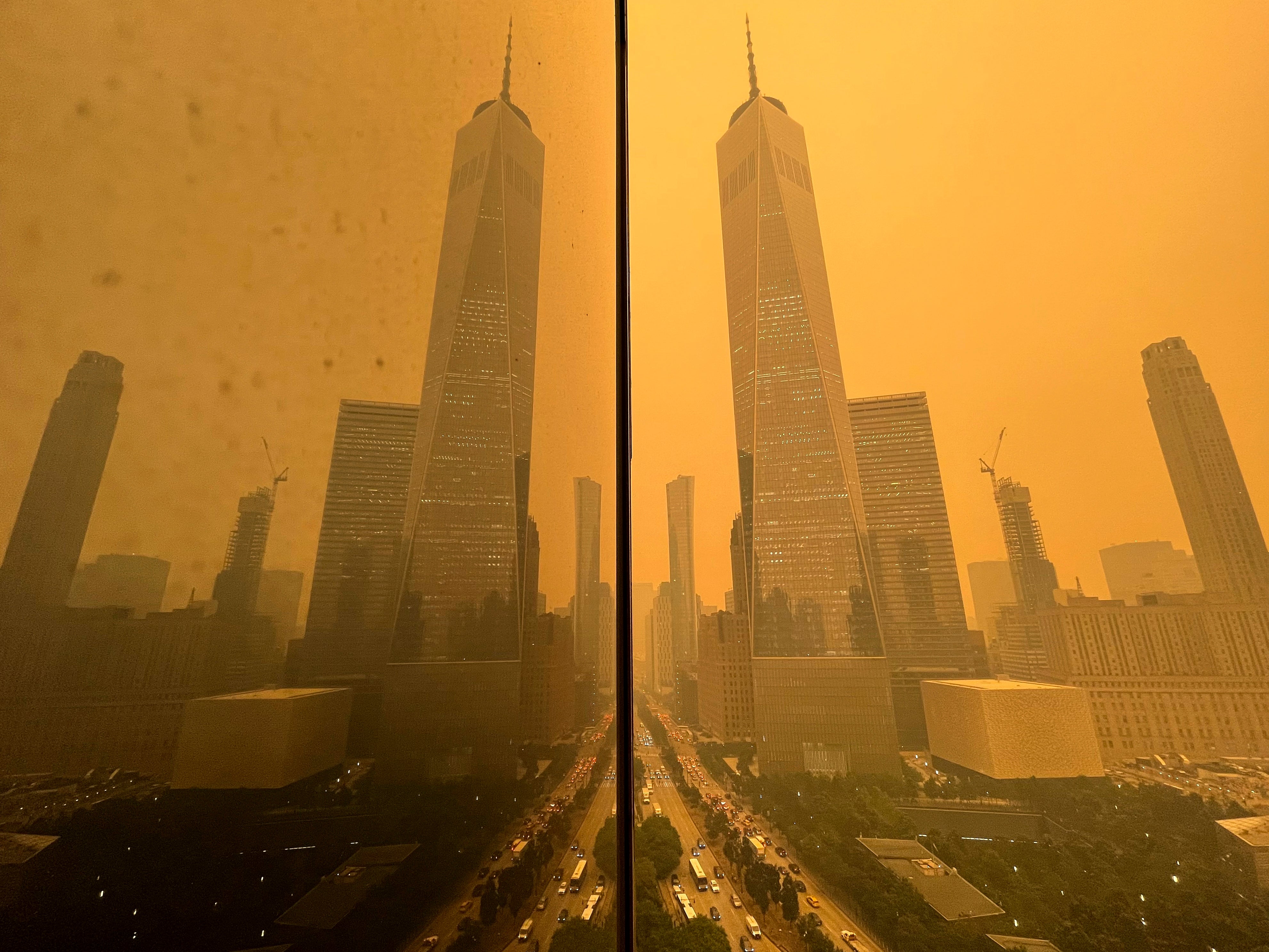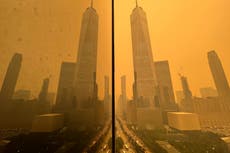When do experts think the wildfire smoke will clear?
Possible rain showers and winds could push smoky conditions westerly over the weekend for the Northeast
The northeast of the United States is battling heavy smoke from 400 wildfires raging across Canada which have burned more than six million acres and led to mass evacuations.
Smoke has darkened skies and made it difficult to breathe in at least half a dozen states and major cities including New York, Toronto, Ottawa, Washington DC and Philadelphia, as well as large parts of Canada.
In areas with “unhealthy” levels of air pollution, public health officials were advising people to stay indoors and wear masks if outside.
Live: New York’s Central Park clouded in haze from Canadian wildfires
Vulnerable populations including children, the elderly and those with underlying conditions, like asthma and heart disease, should particularly heed the warnings.
And it’s far from over: Canadian officials warned that this could be the country’s worst wildfire season on record.
Which states and cities are affected by smoke?
At least 20 US states have air quality alerts issued in places, impacting an estimated 115 million people.
Major cities like New York, Washington DC, Philadelphia, Detroit, Harrisburg and Dover have borne the brunt of the pollution this week.
As of Friday morning (9 June), the Air Quality Index (AQI) – used by public officials to measure air pollution – was improving in cities like New York, Washington DC and Philadelphia.
New York City’s AQI was 64 on Friday morning while Washington DC’s was 70.
Some cities like Dover, Delaware, had a jump in AQI due to the smoke moving south from the Northeast. Friday morning Dover’s AQI was “Unhealthy” at 160.
The worst of the conditions for New York was on Wednesday (7 June) afternoon when it ranked number one for the worst air quality in the world. At one point, the AQI reached above 350, on a scale that runs from 0-500 – hitting “hazardous” levels.
In a sign of how extreme conditions were, New Delhi – a city where people live under the threat of heavy air pollution much of the year – was in second place with an AQI of 190.

Conditions in the Northeast began improving on Thursday, though all people, especially vulnerable populations, were still recommended to limit outdoor activities.
Some flights from airports in the tri-state area faced delays due to the smoky conditions on Thursday. But by Friday, skies were much clearer.
Which direction is the smoke moving?
Parts of the Northeast began experiencing some relief from the thick smoke that pushed south from Canada on Friday.
New York City, Philadelphia, Pittsburgh, Washington DC and other cities saw inklings of clearer skies as the AQI began to drop toward more normal levels.
According to the National Weather Service (NWS), the flow of smoke over the Northeast will begin shifting more westerly by Saturday.
“Pockets of denser smoke could significantly reduce air quality and lead to lowering visibility, with a wider region of light to moderate smoke leading to an opaque sky and orange sunsets / sunrises,” The NWS said on Friday morning.
States in the Mid-Atlantic region from Michigan and Indiana will likely still face Air Quality Alerts as smoke travels closer toward the area.
In New York City, Air Quality Alerts remained in effect until Friday at midnight with outdoor AQIs predicted to be greater than 100.
As of Friday at 10am local time, the AQI was below 100 with a “Moderate” warning.
The fires have been burning for weeks. Why is it smoky now?
The fires in Quebec province started last weekend and blazes in Nova Scotia, on the Atlantic Coast, began last month.
A storm system off Canada’s east coast is pushing the smoke south over the United States. This weather pattern is expected to continue until at least the weekend.
The National Weather Service said that while the wildfires in Canada remain “large, uncontained, and active, they will likely continue to generate smoke”.
“So in the next week or two at the very least, a lot will be determined by the wind direction and where that causes the smoke to spread,” the agency added.
The weather pattern will remain much the same through this weekend. A stalled low-pressure system near Maine and the Canadian Maritime Province means northerly winds from the fires in Quebec will direct the smoke into portions of the east coast, NWS noted.
This article is being updated
Join our commenting forum
Join thought-provoking conversations, follow other Independent readers and see their replies
Comments


Bookmark popover
Removed from bookmarks